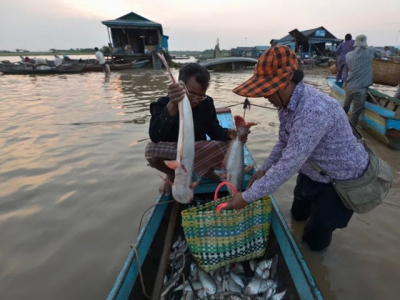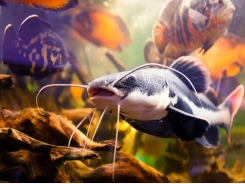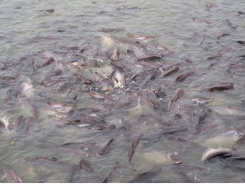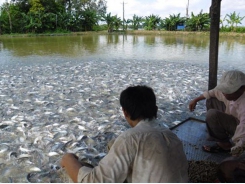Pangasius farming - Water quality and biosecurity

Maintaining good water quality and strict biosecurity measures can help pangasius farms remain productive and profitable.
Pangasius producers have noted the relationship between water quality and disease. Photo: Sylvann Borei
As production from aquaculture increases, one area that requires attention is disease. Disease outbreaks can occur depending on fish health, environmental conditions and the presence of pathogens, so it is important that fish farmers know what practices increase or decrease the risk of disease.
Biosecurity refers to methods that prevent, control and eradicate any infectious disease. Examples include cleaning and disinfecting production facilities and maintaining good water quality.
The deterioration of water quality due to factors such as high feeding rates and fish waste is the principal limiting factor to aquaculture production. Fish depend on water to feed, breathe, excrete waste, grow and reproduce so understanding the physical and chemical qualities of water is critical.
It goes without saying that water quality is just as important in Pangasius farming, and must be monitored closely to ensure growth, disease prevention and survival.
Water requirements of pangasius
Pangasius can absorb oxygen directly from the atmosphere thanks to a modified swim bladder, and this greatly reduces the need for aeration in ponds.
Monitoring water quality parameters like dissolved oxygen and pH are critical when farming pangasius
Even in heavily stocked pangasius ponds without aeration, the amount of dissolved oxygen does not decline to critical levels, possibly due to the ability of pangasius to use atmospheric oxygen to meet its physiological and metabolic requirements as well as its consumption of living organisms in pond soil, and other organic matter.
The presence of pangasius in ponds can be considered to potentially improve soil and water quality and carrying capacity due to the fish's ability to use atmospheric oxygen. Being a facultative air breather, pangasius can tolerate dissolved oxygen as low as 0.05 - 0.10mg/litre.
The water requirements of pangasius:
Temperature should be kept between 22-30°C, with
pH between 6.5 and 9.5.
Turbidity needs to be around 10-15 (FTU)
Dissolved oxygen in the range of 2.5 - 7.5mg/l.
Total alkalinity should be between 15 and 25.7mg/l
Total ammonia nitrogen at 0.7 - 1mg/l
Salinity at <2 ppt
Total hardness 15.3 - 35.5mg/l
Chloride at a level of <550mg/l.
Pangasius does not tolerate water temperatures below 14C for long periods of time as growth rates are reduced and it becomes less resistant to disease.
How to maintain water quality
Water is home to thousands of ions, elements and compounds, many of which are required for the good health and performance of pangasius.
The ASC recommends that farmers track the type and amount of feed they use as part of water quality chekcs
Water quality parameters that must be checked include temperature, dissolved oxygen, pH, nitrite levels, salinity, alkalinity, hardness and ammonia. Other factors that can significantly affect water quality include light and suspended solids (sand, mud or coral).
Agricultural limestone helps maintain alkalinity and hardness and control turbidity, while soluble carbonate or bicarbonate sources can be used to keep pH at the required level. Filters can trap any unnecessary solids after the water has been passed through.
To monitor nitrogen and phosphorus, the Aquaculture Stewardship Council (ASC)'s Better Management Practices for Pangasius Aquaculture recommends that farmers record the type and amount of feed used, keep samples of the feed, and send them regularly to a laboratory for analysis.
The ASC Practices also state that the rate of photosynthesis and respiration in a given water body can cause oxygen levels to fluctuate, and that the best way to observe this fluctuation is to compare early morning and late afternoon levels of dissolved oxygen (because of plant and animal respiration, dissolved oxygen levels tend to be low in the early morning and high in the late afternoon after photosynthetic activity that releases oxygen in the water during the day).
A good indicator of biological activity in the water is the percentage change in dissolved oxygen (a lower value of percentage change means that the water quality is high).
The Practices also suggest that dissolved oxygen is measured twice during the day, once before sunrise and two hours before sunset, to get an idea of the maximum and minimum levels, while a hand-held oxygen meter can be used to measure salinity and temperature as well as dissolved oxygen.
An accurate and reliable understanding of water quality parameters is key to successful and sustainable Pangasius farming with environmentally friendly practices.
Areas such as water temperature should be carefully regulated, dedicated equipment (nets, brushes) should be disinfected and the health of Pangasius routinely monitored.
Biosecurity can be applied through a variety of management strategies and by following polices and guidelines that have been agreed upon internationally. Given the attention on the sustainability of Pangasius farming, further research is required into the different methods proposed and their exact costs.
Related news
Tools

Phối trộn thức ăn chăn nuôi

Pha dung dịch thủy canh

Định mức cho tôm ăn

Phối trộn phân bón NPK

Xác định tỷ lệ tôm sống

Chuyển đổi đơn vị phân bón

Xác định công suất sục khí

Chuyển đổi đơn vị tôm

Tính diện tích nhà kính

Tính thể tích ao




 How Aflatoxins threaten pangasius catfish production
How Aflatoxins threaten pangasius catfish production  Pangasius farming - Feed and nutrition
Pangasius farming - Feed and nutrition